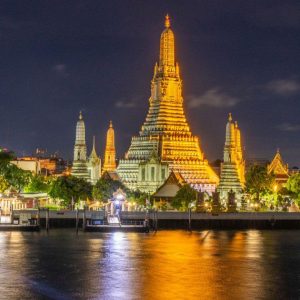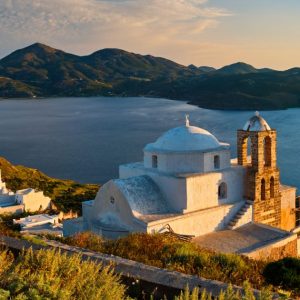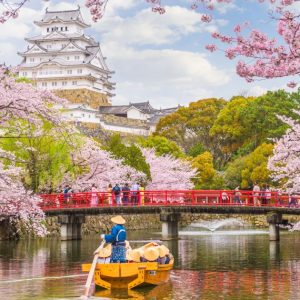The girls have `big’ hair, piled elegantly on the top of their heads. Their dresses have colourful, flounced skirts, tight bodices, and rather naughtily, their breasts are bare. They look like perfect party girls to me and their menfolk like dandies in their designer loincloths. They could be in some exotic place right now except that they were painted around 3450 years ago. In Heraklion’s Archaeological Museum, the lives of the Minoans – Crete’s early residents – are on full display. Gazing at the frescoes of their opulent life, the tiny painted cups they used, their snake goddess statues, fills me with amazement. Yet this is just the beginning. There’s no better way to explore Crete than to go in search of the mysterious Minoans whose palaces and settlements are scattered all over the island and the museum makes a perfect launching pad for the journey.
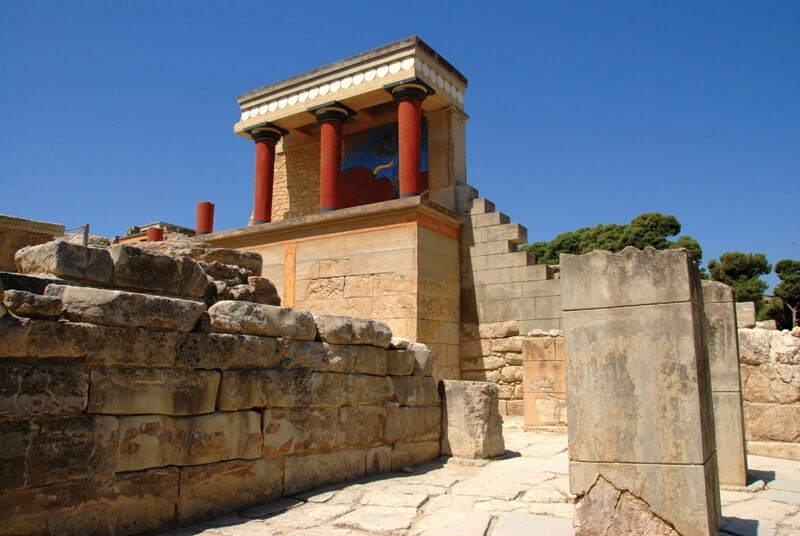 It will take you deep into Crete’s awesomely dramatic landscape, along the lovely beaches that fringe its coast and through its mountainous uplands. A host of legends about its mythical past have added to Crete’s allure. Yet not much more than a century ago it was discovered that it was the home of Europe’s oldest civilization and a glittering Bronze Age empire. A 20-minute bus ride from Heraklion takes you to its most illustrious centre, Knossos Palace. It was here that British archaeologist, Sir Arthur Evans, unearthed the spectacular palace of a civilization he called the Minoan, after the legendary king, Minos. Not surprisingly, Knossos is a real crowd-puller so it’s best to explore early or late in the day if you can.
It will take you deep into Crete’s awesomely dramatic landscape, along the lovely beaches that fringe its coast and through its mountainous uplands. A host of legends about its mythical past have added to Crete’s allure. Yet not much more than a century ago it was discovered that it was the home of Europe’s oldest civilization and a glittering Bronze Age empire. A 20-minute bus ride from Heraklion takes you to its most illustrious centre, Knossos Palace. It was here that British archaeologist, Sir Arthur Evans, unearthed the spectacular palace of a civilization he called the Minoan, after the legendary king, Minos. Not surprisingly, Knossos is a real crowd-puller so it’s best to explore early or late in the day if you can.
Sprawling over a hillside, the scope and sophistication of the palace is astonishing.
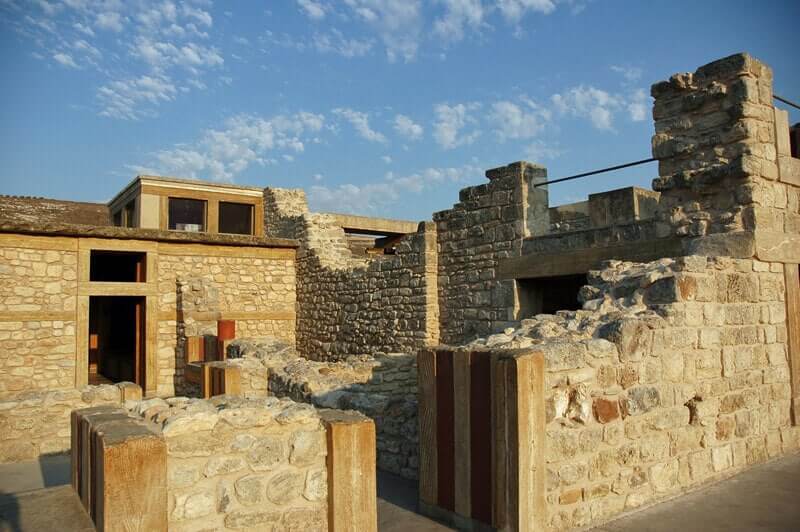 A great courtyard lies at its centre and broad staircases lead between the floors of the palace that was once several storeys high. The queen’s apartments look perfectly lavish and a throne room, complete with an alabaster stone throne, remains. The palace’s complex design and the Minoan’s obsession with bulls may well have prompted the legend of the Minotaur, half man-half bull, which supposedly lurked in a labyrinth here and the bulls horns and double axe heads here are powerful icons of Minoan culture. Evans controversially, partially reconstructed the palace that was at its latest peak around 1450 BC and copies of the luxuriant frescoes found here are scattered around. My favourite spot though is the Royal Road that leads up the hillside beside the palace – possibly Europe’s oldest surviving road.
A great courtyard lies at its centre and broad staircases lead between the floors of the palace that was once several storeys high. The queen’s apartments look perfectly lavish and a throne room, complete with an alabaster stone throne, remains. The palace’s complex design and the Minoan’s obsession with bulls may well have prompted the legend of the Minotaur, half man-half bull, which supposedly lurked in a labyrinth here and the bulls horns and double axe heads here are powerful icons of Minoan culture. Evans controversially, partially reconstructed the palace that was at its latest peak around 1450 BC and copies of the luxuriant frescoes found here are scattered around. My favourite spot though is the Royal Road that leads up the hillside beside the palace – possibly Europe’s oldest surviving road.
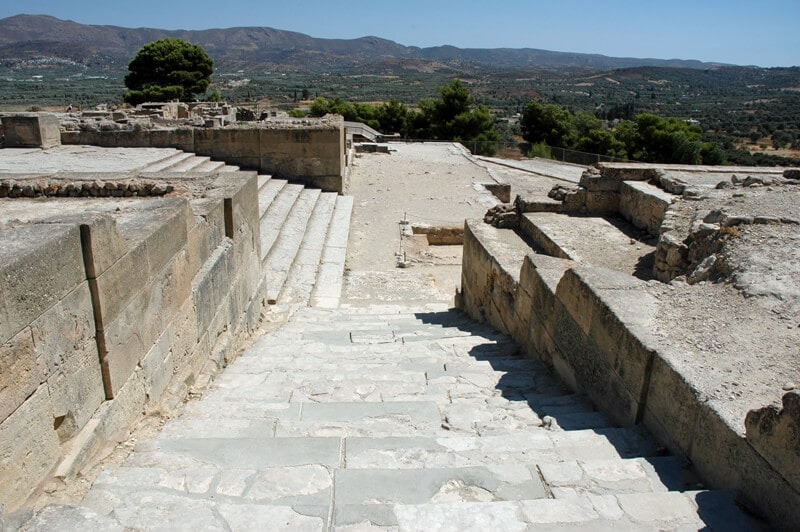 Head south inland through the centre of the island and you’ll discover another of the great palace complexes. Lying on the Messara plain overlooked by the soaring Mount Ida, Phaistos is an arrestingly beautiful site with a mysterious air. Each palace, I’ve found, has its own distinct character, though their layout is similar. A monumental staircase leads you into the palace with its array of courts and halls and royal apartments. The vast storage jars in place in its storerooms make an impressive sight and there is an entire theatre area here too. It was here that the intriguing Phaistos Disc was found. Inscribed with symbols which have yet to be diciphered, it’s on display in the Heraklion museum.
Head south inland through the centre of the island and you’ll discover another of the great palace complexes. Lying on the Messara plain overlooked by the soaring Mount Ida, Phaistos is an arrestingly beautiful site with a mysterious air. Each palace, I’ve found, has its own distinct character, though their layout is similar. A monumental staircase leads you into the palace with its array of courts and halls and royal apartments. The vast storage jars in place in its storerooms make an impressive sight and there is an entire theatre area here too. It was here that the intriguing Phaistos Disc was found. Inscribed with symbols which have yet to be diciphered, it’s on display in the Heraklion museum.
Beside the Libyan Sea nearby, lies the lovely site of Agia Triada. Its medley of remains of a Minoan villa, a house and village are shaded by trees and filled with birdsong. Here you can clearly make out halls, storerooms and shops and one room retains its fitted benches. Many artefacts were found here, including the miraculous Harvester Vase, which shows a procession of the locals celebrating at harvest time.
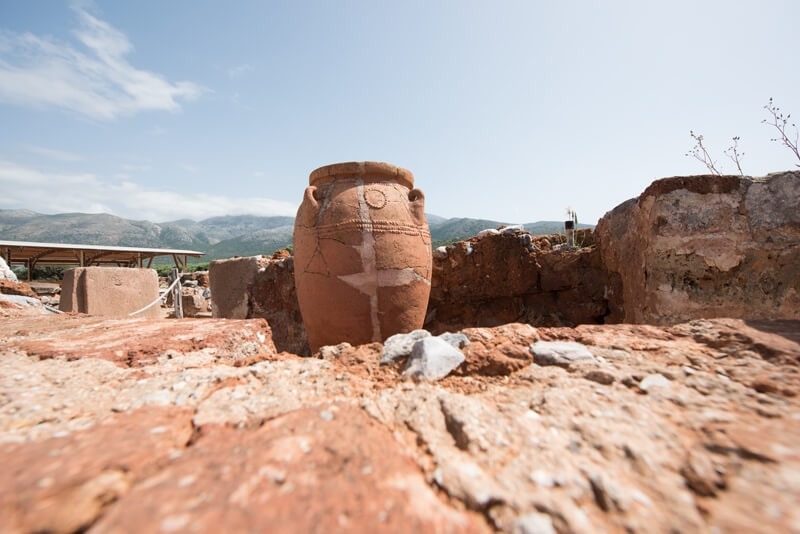 East of Heraklion, near the resort town of Malia, lies another of the most imposing Minoan palaces. Just beyond a popular beach, the site is still being uncovered by archaeologists. The great pillars that supported the palace’s upper floors and the staircases that led to them can be seen and you’ll find the double axe symbol etched into pillars here too. Look out for the intriguing Malia Table, a huge circle of stone with hollows carved in it, thought to be a cult object. A large area that housed workshops lies beside the palace which overlooks fields strew with wildflowers in spring.
East of Heraklion, near the resort town of Malia, lies another of the most imposing Minoan palaces. Just beyond a popular beach, the site is still being uncovered by archaeologists. The great pillars that supported the palace’s upper floors and the staircases that led to them can be seen and you’ll find the double axe symbol etched into pillars here too. Look out for the intriguing Malia Table, a huge circle of stone with hollows carved in it, thought to be a cult object. A large area that housed workshops lies beside the palace which overlooks fields strew with wildflowers in spring.
Further on, at the easternmost tip of the island, Zakros is quite remote so you’ll often have the place almost to yourself. A few tavernas fringe the beach and only the sound of the sea lapping on the shore disturbs the silence. The lustral basin in the palace here is my favourite as small terrapins live in its dark waters. The smaller palace complex is bordered by the remains of a domestic quarter which cover the hillside. Like Knossos, Zakros too has a road that winds its way up the hill from the palace, and it too is original.
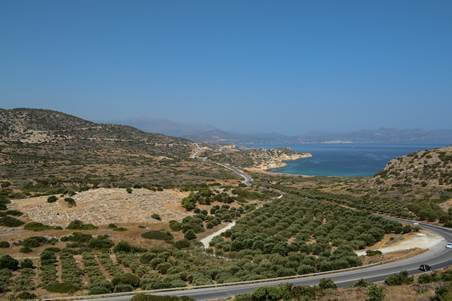 But the Minoan sites on the island are not all palaces and villas. Past Agios Nikolaos in the northeast, by the coast, lies Gournia, the best preserved Minoan town in Crete. The steps that lead up to its tiny houses in its maze of streets have survived. Gaze out over the remains of this town to the sea and its ancient life seems not so distant. You’ll have to return many times to see more of the great array of Minoan sites on Crete but the journeys will be worth it: each one is a potent and unforgettable reminder of the island’s extraordinary past.
But the Minoan sites on the island are not all palaces and villas. Past Agios Nikolaos in the northeast, by the coast, lies Gournia, the best preserved Minoan town in Crete. The steps that lead up to its tiny houses in its maze of streets have survived. Gaze out over the remains of this town to the sea and its ancient life seems not so distant. You’ll have to return many times to see more of the great array of Minoan sites on Crete but the journeys will be worth it: each one is a potent and unforgettable reminder of the island’s extraordinary past.
Images courtesy of www.incrediblecrete.gr and Region of Crete.

